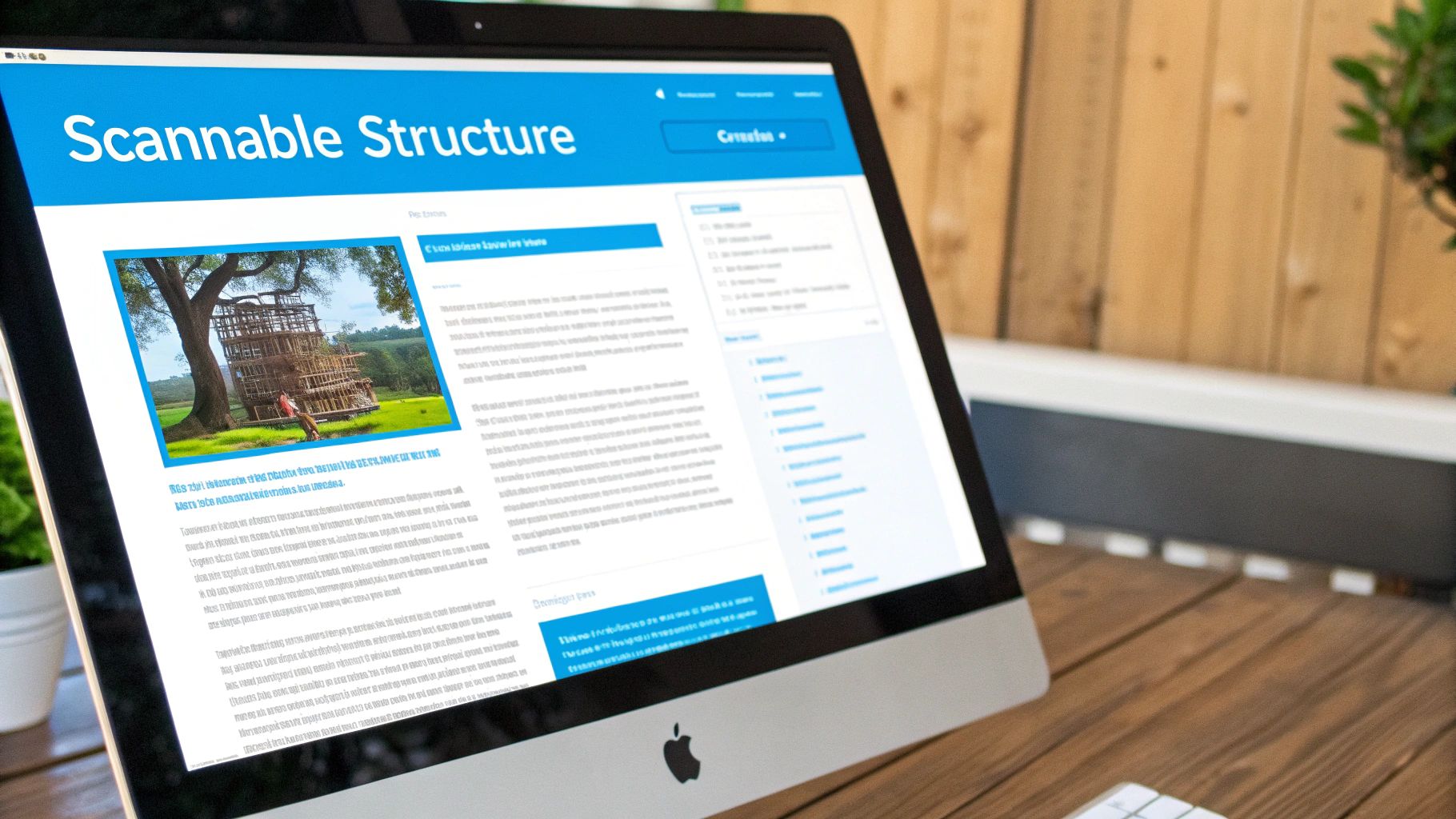7 Essential Blog Post Writing Tips for Success in 2025

In a world saturated with content, simply writing a blog post isn't enough. The real challenge is crafting one that captures attention, engages readers from the first sentence to the last, and ranks well on search engines. Many writers struggle to balance creativity with SEO, leading to content that either goes unread or fails to connect. This guide bypasses generic advice, offering potent, actionable blog post writing tips designed for today's landscape.
Each strategy is a building block for creating content that not only gets discovered but also builds a loyal audience. We'll explore how top marketers craft compelling narratives, structure posts for maximum scannability, and drive meaningful action. To truly transform your ideas into standout content, it's essential to apply proven techniques to boost creativity throughout your writing journey. Prepare to master the art of effective blog writing for 2025 and beyond.
1. Tip 1: Master the Art of Compelling Headlines
Your headline is the single most important element of your content. Advertising pioneer David Ogilvy famously stated that five times as many people read the headline as read the body copy. If your headline fails to grab attention, the rest of your meticulously crafted blog post writing tips and insights will go unread. It’s your first and only chance to convince a potential reader to click instead of scroll.
A compelling headline makes a specific promise, highlights a clear benefit, and sparks curiosity without resorting to clickbait. It must accurately represent your content while immediately answering the reader's unspoken question: "What's in it for me?" This approach moves beyond simply summarizing the topic; it actively sells the value contained within the post, making it a critical first step in the reader's journey.
Actionable Steps for Better Headlines
To create headlines that consistently perform, integrate these strategies into your workflow:
- Use Headline Analyzers: Leverage free tools like CoSchedule’s Headline Analyzer or Sharethrough's Headline Analyzer. These platforms score your headline based on clarity, sentiment, and length, providing data-driven suggestions for improvement.
- Incorporate Target Keywords: Naturally place your primary keyword near the beginning of the headline. This not only signals relevance to readers but also helps search engines understand your content's focus. For example, "Blog Post Writing Tips for Beginners Who Want to Rank."
- A/B Test Variations: Never settle for your first idea. Write at least 5-10 different headlines for every post and use your CMS or email marketing software to test which one drives the most clicks.
- Add Context with Brackets: Use brackets or parentheses to provide extra value and increase click-through rates. Examples include "[Infographic]," "[New Data]," or "[Step-by-Step Guide]." This simple addition sets clear expectations for the reader.
2. Know Your Target Audience
Writing without an audience in mind is like sending a letter to "occupant"; it's impersonal and easily ignored. Truly effective blog post writing tips always begin with understanding your reader. This means going beyond basic demographics to uncover their specific goals, challenges, and motivations. Content marketing pioneers like Seth Godin and Ann Handley built their success on this principle: when you write directly to a well-defined person, your message resonates on a much deeper level.
Understanding your audience allows you to tailor your tone, choose relevant examples, and provide solutions that genuinely help. This targeted approach transforms your content from a generic broadcast into a valuable, one-on-one conversation. It's the foundation for building a loyal community that not only reads your content but also trusts and acts on your advice. Knowing who you're writing for is crucial; for instance, if you're struggling to connect with them, it might be a sign of a creative hurdle. You can learn more about how to bypass writer's block by refining your audience focus.
Actionable Steps to Understand Your Audience
To create content that consistently connects, integrate these research strategies into your content creation process:
- Create Detailed Buyer Personas: Move beyond simple descriptions. Give your ideal reader a name, a job title, goals, and specific pain points. For example, HubSpot creates detailed personas like "Marketing Mary" to guide their content strategy.
- Analyze Your Analytics: Use Google Analytics and social media insights (like Facebook Audience Insights) to gather quantitative data. Look at demographics, interests, and which content formats perform best with your existing audience.
- Join Their Communities: Identify the online forums, LinkedIn groups, or subreddits where your target audience congregates. Observe their conversations, note the questions they ask, and understand the language they use.
- Conduct Surveys and Interviews: Directly ask your current readers or customers about their challenges. Use tools like SurveyMonkey or simple Google Forms to gather direct feedback you can use to fuel your content calendar.
3. Create Scannable Content Structure
Most online readers do not read every word on a page; they scan for specific information. This behavior, confirmed by usability experts like Jakob Nielsen, means a dense wall of text is a major obstacle to engagement. Creating a scannable content structure respects the reader’s time and ensures your key messages are easily accessible. By using headers, short paragraphs, and visual breaks, you guide the reader's eye through the content, making it digestible and far more effective.
This approach is one of the most crucial blog post writing tips for retaining visitors and improving user experience. It acknowledges that clarity and accessibility are just as important as the information itself. When readers can quickly find what they need, they are more likely to stay on the page, absorb your message, and view your brand as a helpful authority.
Actionable Steps for Better Scannability
To transform your posts into scannable masterpieces, follow these proven strategies used by sites like Backlinko and Smart Blogger:
- Use Descriptive Subheadings: Don't just label sections; use H2 and H3 tags to tell a mini-story. A good subheading should give the reader a clear idea of the content that follows, allowing them to jump to the sections most relevant to them.
- Keep Paragraphs Short: Limit paragraphs to a maximum of 2-3 sentences. This creates white space, which makes the text feel less intimidating and easier to read on both desktop and mobile screens.
- Leverage Lists and Bold Text: Use bullet points or numbered lists to break down complex information, steps, or features. Strategically use bold text to highlight key terms and important takeaways, drawing the reader's eye to the most critical points.
- Create a Logical Flow: Ensure your headings and sections follow a coherent sequence. Your structure should guide the reader on a logical journey from introduction to conclusion, making the entire post feel intuitive and easy to follow.
4. Optimize for SEO
Writing a brilliant blog post is only half the battle; if no one can find it, its impact is lost. Search Engine Optimization (SEO) is the process of making your content discoverable to people searching for relevant topics on Google, Bing, and other search engines. It involves a strategic blend of keyword research, on-page optimization, and creating content that directly satisfies a user's search intent.
Effective SEO bridges the gap between what search engine algorithms want and what human readers need. By optimizing your posts, you create a sustainable source of organic traffic, building authority and reaching a wider audience over time. This approach ensures your valuable insights, including these blog post writing tips, don't just exist but actively perform.
Actionable Steps for Better SEO
To get your blog posts ranking higher and driving consistent traffic, integrate these essential SEO practices:
- Perform Keyword Research: Use tools like Ahrefs or Semrush to identify the specific terms and questions your target audience is searching for. Focus on keywords with a healthy search volume and achievable difficulty.
- Optimize On-Page Elements: Naturally include your target keyword in your post's title, URL, H1 tag, and at least one subheading. Weave it into your introduction and conclusion, but always prioritize readability over keyword density.
- Write Compelling Meta Descriptions: Your meta description is a 160-character sales pitch that appears in search results. Write one that accurately summarizes the post and includes a strong call-to-action to encourage clicks.
- Build an Internal Linking Web: Link to other relevant articles on your own blog within your content. This helps search engines discover more of your pages and keeps readers engaged on your site longer.
- Optimize Images: Use descriptive file names (e.g.,
blog-post-seo-tips.jpg) and add relevant alt text to every image. This improves accessibility and helps your images rank in Google Images. For an even deeper dive into optimizing your blog posts for search engines, explore these effective SEO tips for blogs. You can also learn more about how AI is shaping SEO best practices on word-spinner.com.
5. Start with Strong Introductions
Your introduction is the critical bridge between your compelling headline and your valuable main content. If the headline gets the click, the introduction secures the read. Fail here, and even the most interested reader will hit the back button. A strong intro hooks the audience, validates their decision to click, and sets a clear promise for what they are about to learn. It’s where you have just a few seconds to prove your post is worth their time.
An effective introduction isn't a long-winded summary; it's a strategic opening that connects with the reader's needs. Whether you use a startling statistic, a relatable anecdote, or a direct question, the goal is to create immediate engagement. This is one of the most vital blog post writing tips because it directly impacts bounce rate and average time on page, two key metrics that signal content quality to search engines.
Actionable Steps for Better Introductions
To craft introductions that captivate readers from the first sentence, apply these proven techniques:
- Use the APP Method: Acknowledge the reader's problem, Promise a solution, and give a Preview of the content. This formula, popularized by bloggers like Brian Dean, quickly establishes relevance and shows the reader exactly what's in it for them.
- Start with a Hook: Open with a powerful element like a surprising statistic, a thought-provoking question, a bold statement, or a very short, relevant story. Ann Handley of MarketingProfs is a master of using storytelling hooks to draw readers in immediately.
- Keep it Concise: Your introduction should be laser-focused. Aim for under 100 words or 3-4 short paragraphs at most. Get straight to the point and eliminate any fluff that doesn't serve to engage the reader or set the stage.
- Address the Reader Directly: Use "you" and "your" to speak directly to the reader. This creates a conversational tone and makes the content feel more personal and relevant, a technique frequently used by successful bloggers like Jon Morrow of Smart Blogger.
6. Use Data and Examples
Supporting your claims with credible data, research, and real-world examples is what separates flimsy opinion pieces from authoritative content. When you back up your points with evidence, you build immediate trust and credibility with your audience. This approach transforms abstract concepts into tangible, understandable insights and provides definitive proof for the statements you make, making your content far more memorable and actionable.
Data-driven content consistently earns more respect from readers and performs better in search engine rankings and social shares. Pioneers like Brian Dean of Backlinko and the team at HubSpot have built empires on this principle, using original research and comprehensive reports to become go-to resources in their fields. This is one of the most effective blog post writing tips for establishing expertise.
Actionable Steps for Data-Driven Content
To effectively integrate data and examples into your posts, follow these best practices:
- Cite Recent, Credible Sources: Always use data from reputable sources like academic journals, industry studies, or government reports. Ensure the data is recent, as outdated statistics can quickly undermine your credibility. Properly link to your sources to show transparency.
- Balance Data with Storytelling: Don't just list statistics. Weave them into a compelling narrative that illustrates their importance. Explain what the numbers mean for your reader and use them to support the story you're telling.
- Include Visual Evidence: Use screenshots, charts, and graphs to present data visually. This makes complex information easier to digest and breaks up long blocks of text, improving the reader's experience.
- Create Original Research: When possible, conduct your own surveys, experiments, or case studies. Original data is highly linkable and positions you as a leading authority. You can even use AI tools to help analyze and structure data for your reports.
7. Include Clear Call-to-Actions
A blog post without a call-to-action (CTA) is a missed opportunity. Your content's purpose isn't just to inform; it's to guide the reader toward a specific next step. A CTA bridges the gap between passive reading and active engagement, transforming a reader into a subscriber, a follower, or a customer. It is the crucial element that tells your audience exactly what to do next, ensuring your content serves a strategic business goal beyond simply attracting traffic.
Failing to include a clear CTA leaves your reader at a dead end. After investing time in your post, they are at peak engagement and most receptive to a relevant offer. Whether you want them to subscribe, share, or download a resource, the CTA provides a direct and logical path. This is a fundamental part of the best blog post writing tips because it turns your content into a powerful conversion tool.
Actionable Steps for Better CTAs
To create CTAs that effectively drive action, implement these strategies into your content creation process:
- Use Action-Oriented Language: Start your CTA with a strong verb that commands action. Words like "Download," "Subscribe," "Get," "Join," or "Start" are direct and eliminate ambiguity. Instead of "Our newsletter is available," use "Get a weekly digest of marketing tips."
- Offer Specific Value: A generic "Click Here" is uninspiring. Your CTA must clearly communicate the benefit. For instance, Copyblogger excels at offering content upgrades like checklists or templates, making the value proposition irresistible.
- Place CTAs Strategically: Don't just save your CTA for the very end. Place them at natural break points in your content where a reader might pause, such as after a key section or before the conclusion. This captures readers who don't finish the entire post.
- Test and Optimize: Experiment with different CTA button colors, text, and placements. Use A/B testing tools to see what resonates most with your audience. Pat Flynn of Smart Passive Income frequently tests various CTA styles to maximize email sign-ups. If you are struggling with wording your CTAs to sound more natural, you might want to learn more about using a blog-friendly AI humanizer to refine your copy.
7 Key Blog Writing Tips Comparison
| Item | Implementation Complexity 🔄 | Resource Requirements ⚡ | Expected Outcomes 📊 | Ideal Use Cases 💡 | Key Advantages ⭐ |
|---|---|---|---|---|---|
| Write Compelling Headlines | Medium – Requires creativity & testing | Moderate – Tools for analysis & SEO | Higher click-through rates and engagement | Blog posts, social media, email subject lines | Grabs attention quickly, boosts SEO & shares |
| Know Your Target Audience | High – In-depth research needed | High – Analytics, surveys, interviews | Better content relevance and conversion rates | Content strategy, marketing campaigns | Tailors content effectively, builds loyalty |
| Create Scannable Content Structure | Medium – Formatting and design effort | Moderate – Formatting tools, visual assets | Improved readability and user experience | Blog posts, guides, mobile content | Enhances engagement, boosts SEO and readability |
| Optimize for SEO | High – Technical and ongoing updates | Moderate to High – Keyword tools, SEO audits | Increased organic traffic and long-term growth | Any online content aiming for search visibility | Drives targeted traffic, cost-effective |
| Start with Strong Introductions | Medium – Requires audience insight | Low to Moderate – Writing and editing time | Reduced bounce rate and increased reader engagement | Blog posts, articles, storytelling content | Hooks readers, sets tone and expectations |
| Use Data and Examples | High – Research and validation needed | High – Data gathering, analysis tools | Builds credibility and improves content trust | Reports, case studies, research-based content | Adds authority, enhances memorability |
| Include Clear Call-to-Actions | Low to Medium – Strategic placement | Low to Moderate – Design and copywriting | Increased conversions and engagement | Landing pages, newsletters, promotional content | Guides readers, maximizes ROI |
Putting These Writing Tips Into Practice
Mastering the art of writing impactful blog posts is an ongoing process, not a final destination. The seven strategies we've explored provide a powerful framework for creating content that truly connects and performs. From crafting magnetic headlines that demand attention to embedding clear calls-to-action that guide your reader, each tip is a vital piece of the content puzzle.
The true key to success lies in consistent application and refinement. Don't feel overwhelmed; start by focusing on just one or two of these blog post writing tips in your next article. Perhaps you can dedicate extra effort to deepening your audience research or make your content structure more scannable with strategic formatting. As you methodically integrate these concepts, you will build powerful habits. For those looking to broaden their toolkit even further, exploring additional Brilliant Blogging Tips and Tricks can provide fresh perspectives to elevate your content.
Ultimately, the goal is to move beyond simply sharing information and start building a meaningful dialogue with your audience. By applying these actionable insights, you'll not only see tangible results like better engagement and higher search rankings but also foster a loyal community around your brand. These techniques empower you to transform a simple article into a valuable asset that educates, persuades, and inspires. Now, take this framework, apply it with your unique voice, and start writing your next standout post.
Ready to refine your drafts and make every sentence count? Word Spinner is the perfect tool to help you rephrase content, improve clarity, and find the perfect words to engage your audience. Use our advanced rewriter to implement these blog post writing tips more efficiently and ensure your final piece is polished and powerful.



